Main page
About us
Sliding Bearings Consulting
Advertising Opportunities

to Fluids
to Dispersions
Homogenization
Homogenization, mixing, blending, stirring
Homogenization is a physical process of making a uniform dispersion from a mixture of substances.
Generally two actions are involved in a process of homogenization:
- Dispersion (subdivision, breaking) of the particles of the dispersed phase (e.g. reducing oil droplets size in a water emulsion).
- Distribution of the particles throughout the dispersion media (continuous phase) with a minimal variances of the mass concentration, particle size and shape, temperature and other.
However the term homogenization is often used for actions not involving subdivision of particles such as mixing powders or preparation of a dispersions with solid dispersed phase, such as sols and gels.
There are several actions closely referring homogenization:
- Mixing is a physical process of combining two or more substances which form a system of phases - components retaining their physical and chemical forms. Mixing does not imply chemical reactions between the components or a dissolution of one of them in the other.
- Blending is a action of mixing two or more substances until the phases become indistigushable forming a stable dispersion.
- Stirring (agitation) is an continuous or repeated action causing a liquid mixture to move in order to produce a more uniform dispersion and distribution of the constituents.
Mechanisms of mixing
Mixing is performed by one or combination of the following mechanisms:
- Convection mechanism provides macro-mixing by transferring groups of dispersed particles to various regions of the mixing vessel.
- Diffusion mechanism acts in the scale of an individual particle (micro-mixing) slowly and randomly moving through the dispersion media.
- Shear mechanism works in the semi-microscopic level. Shear stresses produce slip zones in the mixture, and the particles located in different layers of the zones interchange their positions.
Mechanical homogenization
Mechanical mixing is the most popular method of homogenization.
The dominant mixing mechanism of mechanical mixing is convection. The mixer creates rotating movements (laminar and turbulent) of the mixture in the vessel.
Mechanical mixing is characterized by low mixing energy density.
- Unbaffled stirred tank is the simplest mechanical mixer.
It consists of a vessel and a vertical motor driven stirrer shaft equipped with at least one impeller (agitator).
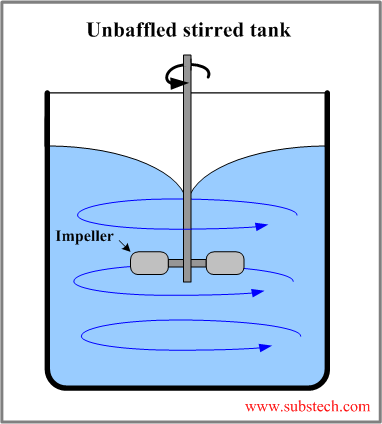
Unbaffled stirred tank produces swirling motion of the mixture forming a central vortex.
The effectiveness of the mixing process in unbaffled stirred tanks is relatively low.
- Baffled stirred tank provides more effective mixing effect due to the baffles - plates mounted radially to the vessel wall. The baffles supress a formation of the central surface vortex and generate a complex rotational flows (eddies) within the stirred vessel.
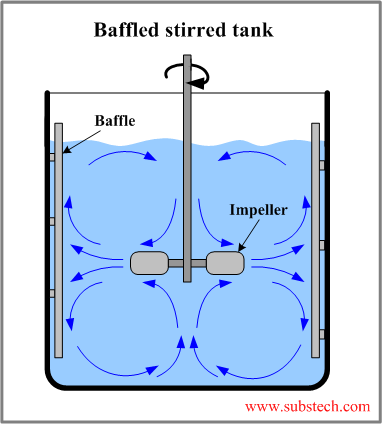
The effectiveness of mixing also depends on the type of the impeller.
Propellers and blade turbine impellers are used for homogenization of low and medium viscosity (1-104 centipoise) mixtures.
Anchors and paddles are most effective in the medium viscosity (102-104 centipoise)liquids.
Helical impellers operate with high viscosity (104-106 centipoise)liquid mixtures.
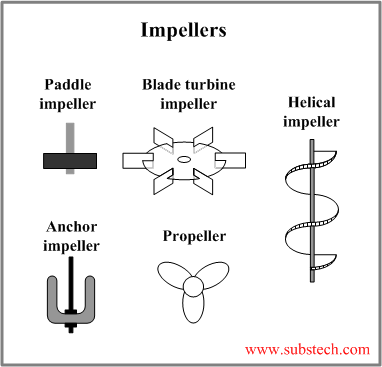
to top
Ultrasonic homogenization
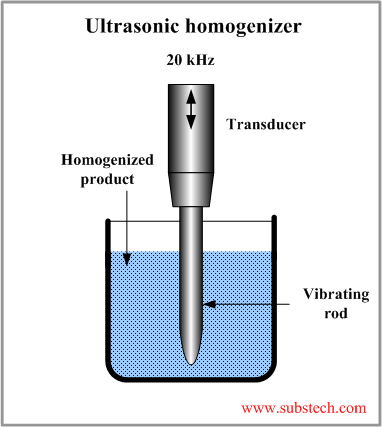 Ultrasonic homogenization is a technique of dispersions processing, which utilizes ultrasonic waves for homogeneous distribution of the dispersed phase by the following actions: reducing the sizes of the dispersed particles/droplets (breaking); disintegrating the dispersed particles agglomerates; blending the dispersed phase in the liquid.
Ultrasonic homogenization is a technique of dispersions processing, which utilizes ultrasonic waves for homogeneous distribution of the dispersed phase by the following actions: reducing the sizes of the dispersed particles/droplets (breaking); disintegrating the dispersed particles agglomerates; blending the dispersed phase in the liquid.
Ultrasonic homogenizing is a result of acoustic cavitation.
The cavitation bubbles form at low pressure part of the of the wave cycle.
When the pressure rises the cavities contract at high velocity.
Such collapse creates a localized impact pressure (up to 20000 psi/1380 bar), which breaks the particles (or liquid globules in emulsions), disintegrate the particles agglomerates and produces high speed (up to ~600 mph/1000 km/h) turbulent streams blending the dispersed phase.
Ultrasonic homogenizing may be applied for processing of various volumes of liquids (resins, Paints, Adhesives, coatings, Lubricants, inks, food emulsions, etc.) in the range from 1 ml to 2000 l.
to top
High pressure homogenization
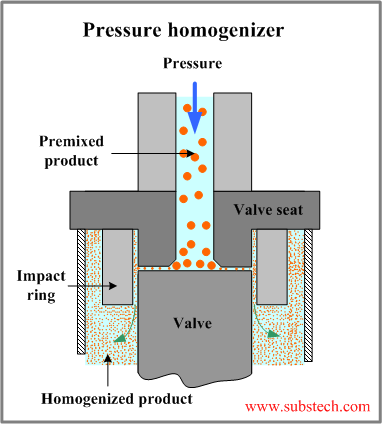 High pressure homogenizers are used for creatting homogeneous dispersions.
High pressure homogenizers are used for creatting homogeneous dispersions.
The premixed liquid is passing under a high pressure (100-1500 bar / 1450-21750 psi )through a minute gap of the homogenizing valve.
Such conditions generate very high shear stresses, acceleration, impact and intense turbulent flows in the liquid resulting in subdivision of the dispersion phase particles or droplets and their homogeneous distribution throughout the mixture.
High disruptive energy generated by high pressure homogenizers makes this method produces extremely fine dispersions with the particle size of about 40μinch (1μm).
High pressure homogenization is widely used in the pharmaceutic and food industry (milk, cream etc.).
to top
Related internal links


